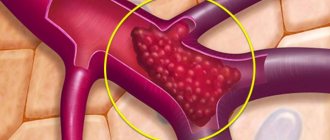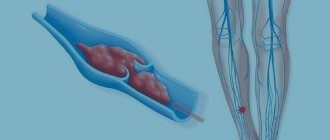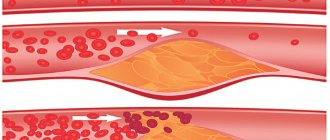Vein thrombosis is a serious and dangerous disease that, in the absence of correct treatment and prevention, can lead to death. Blood clots sometimes form even for no apparent reason, but most often there are provoking factors - recent surgeries, injuries. To reduce risks, drug therapy is indicated. What medications do doctors prescribe for thrombosis? What is the difference between anticoagulants and antiplatelet agents?
Risk factors for thrombosis
Thrombosis occurs not only in older people, but also in young people. The reason for this is a number of factors that do not themselves lead to the formation of blood clots, but create all the conditions for this. The likelihood of forming blood clots increases in the following cases:
- overweight;
- passive lifestyle;
- forced bed rest for more than three days;
- varicose veins;
- recent myocardial infarction or stroke;
- use of oral contraceptives;
- fractures and injuries of the lower extremities;
- unhealthy diet, unhealthy lifestyle.
Forecast
Although thrombolysis is usually successful, the drugs fail to dissolve blood clots in 25% of patients. Another 12% of patients subsequently develop a blood clot or blockage in a blood vessel.
Thrombolysis alone cannot revive tissue that has already been damaged by poor circulation, so further treatment may be required to address the underlying causes of the clot and restore damaged tissue and organs. Timely dissolution can also prevent the development of post-thrombotic disease and the formation of trophic ulcers on the legs.
How medications help with vein thrombosis
All drugs prescribed for the prevention and treatment of venous thrombosis have a blood-thinning effect, since one of the main causes of the disease is increased blood clotting. They cannot miraculously dissolve existing blood clots, but they do prevent them from enlarging and forming new clots. Medicines to reduce clotting may have different principles of action, but give approximately the same effect. They are taken in courses or on an ongoing basis at the discretion of the attending physician.
Blood thinning medications are selected based on tests, diagnosis, and patient characteristics. Self-medication in this case is unacceptable, as it can lead to serious consequences. One of the main side effects is the risk of bleeding. More often it is minor and manifests itself in the form of bruises and nosebleeds. But an incorrectly selected drug and its dosage can lead to more serious consequences requiring hospitalization.
Blood thinners - differences between anticoagulants and antiplatelet agents
There are two groups of blood thinning drugs - anticoagulants and antiplatelet agents. All of them are intended to prevent thrombosis, but differ in their mechanism of action. Anticoagulants inhibit the activity of proteins involved in blood clotting. Antiplatelet agents prevent platelets from clumping together.
For thrombosis of the veins of the lower extremities, anticoagulants are most often prescribed. Drugs of the second group are indicated more likely for cardiovascular diseases - after valve replacement operations, heart attack or stroke. Their task is to minimize the risk of pulmonary embolism as a result of the formation and separation of a blood clot.
After treatment
You may spend the day in the intensive care unit (ICU). You will be given antithrombotic drugs (heparin) for 12-14 hours to reduce blood clotting. After successful lysis of clots in the veins, a compression stocking or sleeve should be used to speed up the flow of blood. Your vascular surgeon will likely recommend that you take a blood thinner (acetylsalicylic acid or Xarelto). It is possible that Vessel Due F will be prescribed to reduce blood viscosity.
Anticoagulants
Anticoagulants are effective drugs that prevent excessive blood clotting and the formation of dangerous clots. They are divided into two large groups:
- Direct action. Mainly injectable drugs used in hospital settings, such as heparin, rivaroxaban. But there are also medications for oral administration. They act quickly, neutralizing clotting factors in the blood plasma.
- Indirect action. They are vitamin K antagonists and affect coagulation factors, gradually reducing their content in the blood. Many drugs from this group are indicated for continuous use; they begin to act slowly, but the effect lasts a long time. These include Warfarin, Aspirin, Trombital.
Anticoagulants are indicated for deep vein thrombosis, bleeding disorders, prevention of heart attack, stroke.
The most common blood thinners
Drugs in tablet form are excellent for outpatient treatment. Some of them are taken in long courses or on an ongoing basis if there is a high risk of blood clots. Below is a list of the main drugs.
Aspirin
Aspirin is an acetylsalicylic acid drug that has a wide range of uses. Its effect varies depending on the dosage. This is a time-tested, effective antiplatelet agent, especially often prescribed for cardiovascular diseases. In tablets of 50 mg and 100 mg, it is used for continuous use. In a high dose it is indicated for fever, to relieve moderate pain. Can be prescribed for varicose veins, thrombophlebitis.
The tablets irritate the gastric mucosa, so they are recommended to be taken strictly after meals. Erosive and ulcerative diseases of the gastrointestinal tract in the acute stage are a direct contraindication. The medicine is common and relatively safe compared to other antiplatelet agents, but it is still not recommended to take it on an ongoing basis without a doctor’s prescription.
Clopidogrel
An antiplatelet agent prescribed primarily for diseases of the heart and blood vessels - atherosclerosis, coronary artery disease, heart attack, unstable angina. Suppression of platelet aggregation is noted from the first day of administration.
Clopidogrel does not have too many contraindications, but it can cause side effects such as nosebleeds, abdominal pain, and dyspepsia. In patients over 75 years of age, treatment is carried out with caution, in moderate dosage.
Warfarin
One of the most common, frequently prescribed anticoagulants. Widely used for the treatment and prevention of thrombosis of various etiologies, thrombophlebitis, varicose veins, and secondary prevention of myocardial infarction. An excellent drug with repeatedly proven clinical effectiveness and safety. One of the few coagulants allowed during breastfeeding.
The drug can be taken only as prescribed by a doctor, since even many doctors note the difficulty of selecting a dose at the beginning of treatment for each individual patient. In addition, it is necessary to constantly monitor hemostasis indicators.
Trombital
The list can be supplemented with a modern combination drug consisting of acetylsalicylic acid and magnesium hydroxide. The antiplatelet agent prevents the formation of blood clots and, compared to Aspirin, does not irritate the gastric mucosa. For this reason, Trombital is prescribed to people with gastrointestinal diseases.
But the drug is used mainly for cardiac diseases, for the prevention of myocardial infarction, and for unstable angina. To reduce the risk of thrombosis of the veins of the lower extremities, doctors usually give preference to other drugs.
Risks, contraindications and complications
Although dissolution can safely and effectively improve blood flow and eliminate symptoms of thrombosis in many patients, it is not recommended for everyone. Thrombolysis may not be recommended for patients who use blood thinning medications, herbs, or dietary supplements, or for people with certain conditions associated with an increased risk of bleeding. These conditions include:
- High blood pressure
- Active bleeding or severe blood loss
- Hemorrhagic stroke
- Severe kidney disease
- Recent surgery
Thrombolysis may also be associated with an increased risk of complications in patients who are pregnant or elderly, or in people with other medical conditions.
Patients who undergo thrombolysis have a small risk of infection (less than one in 1000) and also a small risk of an allergic reaction to the contrast dye that may be required for imaging.
In addition to the risk of serious internal bleeding, other possible risks include:
- Bruising or bleeding at the access site
- Damage to a blood vessel
- Migration of a blood clot to another part of the vascular system
- Kidney damage in patients with diabetes or other pre-existing kidney disease
- The most serious possible complication is intracranial bleeding, which is potentially fatal. But this complication is rare. Cerebral hemorrhage, which causes a stroke, occurs in less than 1% of patients.
Blood thinners for injection
Direct anticoagulants are most often available in the form of an injection solution. Some are used only in hospitals, others are intended for self-administration by patients. At the moment, two drugs are most widely used.
Fraxiparine
Direct anticoagulant, low molecular weight heparin. Can be used by patients independently as prescribed by a doctor. It comes in a syringe with a small needle. It has a fast but short-lasting effect.
It is often prescribed by doctors for vein thrombosis; according to their observations, in most cases there is a pronounced positive dynamics and regression of the thrombotic process. The drug is potent and is prescribed with caution to elderly people, patients with low body weight, and severe arterial hypertension.
Heparin
One of the most common, frequently used direct-acting anticoagulants, widely used in hospitals for the treatment of patients with cardiovascular diseases, venous thrombosis, pulmonary embolism, and acute myocardial infarction.
Compared to other anticoagulants, it has a low cost, so it still remains the main drug in this group, despite the emergence of more modern analogues. It is practically not used at home due to the complexity of dosing, the injection form and the increased risk of bleeding.
To reduce the risk of thrombosis, in addition to blood-thinning drugs, agents may be prescribed to strengthen the walls of blood vessels and lower cholesterol levels. Considerable importance is attached to lifestyle - giving up bad habits, healthy eating, physical activity. The daily routine depends entirely on the person, and this is already a big step towards the prevention of thrombosis. But to prescribe the correct drug treatment, you need to consult a doctor.
Still have questions about protection against venous thrombosis?
Free consultation with AngioClinic specialists
Author
Salmina Daria Vladimirovna
Geneticist. Graduated from the Chelyabinsk State Medical Academy. She completed an internship at the Northwestern State Medical University named after I.I. Mechnikov.
Surgical treatment of thrombosis
Surgical treatment is used in cases of complicated thrombosis. Indications for the operation are:
- ascending thrombosis of the superficial veins with a tendency to spread the process to the deep venous system;
- floating thrombosis with a high probability of migration;
- limited thrombosis of superficial veins, not amenable to conservative therapy.
The main types of interventions for thrombosis are thrombectomy and various options for phlebectomies - from minimally invasive techniques (crossectomy, Varadi miniphlebectomy) to radical ones. The choice of the type of surgical treatment in all cases depends on the form of thrombosis and the level of damage, the degree of circulatory impairment, and the general condition of the patient.
Medical phlebologists who are proficient in conservative and surgical methods for treating vascular pathology, including minimally invasive ones, will promptly provide qualified assistance for various types of superficial and deep vein thrombosis.









